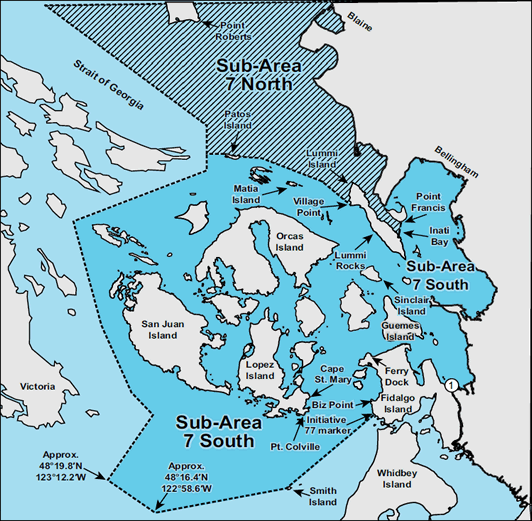Birch Bay is one of the best places in the entire state of Washington to catch crab. In fact, it may rank as one of the best in the NW. When crab season is open you’ll see hundreds of boats on the water dropping their pots.
Birch Bay is located in Marine Area 7 (North – Gulf of Georgia)
For full season dates & other information visit the Washington State Department of Fish and Wildlife website.
Rules:
Dungeness, Red Rock, and Tanner Crab, all fishing methods.
Seasons:
Once opened, crabbing will be allowed Thursdays through Mondays each week. Recreational crabbing will be closed on Tuesdays and Wednesdays, and all crab fishing gear must be removed from the water on closed days by one hour after sunset – gear may not remain in the water.
| Species | Min. size | Daily Limit | Season | Additional Rules |
|---|---|---|---|---|
| Dungeness crab | 6.25″ | Five males | see above |
Must retain back shell while in the field. Must release all soft-shell, females and undersized crab. |
| Red Rock crab | 5″ | Six crab of either sex | see above |
Must retain back shell while in the field. |
| Tanner crab | 4.5″ | Six crab of either sex | see above |
Must retain back shell while in the field. |
The Washington State Department of Fish and Wildlife has designated Birch Bay as part of Marine Area 7 or often referred to as N7 (North 7) or North – Gulf of Georgia. The area extends from Lummi Island in the south all the way up to the Canadian Border and West to the middle of the Strait of Georgia.
While Marine Area 7 also includes a south area most visitor to Birch Bay remain in the North section.
In Birch Bay you can go crabbing by launching a boat, or just wading right in and trying to catch them in the flats.

Anyone age 15 and over is required to have a fishing or shellfishing license to fish for crab in Washington state. In addition, all fishers – regardless of age – are required to have a crab endorsement and a catch record card (CRC) while fishing for crab in Puget Sound.
Recreational crabbers will be issued at one or two catch record cards (CRCs) when they purchase a Puget Sound crab endorsement with a fishing license. One CRC is valid for the summer fishing season, extending from the opening day through Labor Day. The other CRC is valid for the fall/winter fishing season, which extends from the day after Labor Day through December 31st. Crabbers should only request a CRC for the season(s) they intend to harvest.
Summer CRCs and Fall/Winter CRCs must be reported to WDFW by the date printed on each card. Failure to do so will result in a $10 administrative penalty on the next license purchase. Crabbers have the option of returning their completed CRC to WDFW by mail or filing their report on the website listed on the cards.
Crabbing season for Birch Bay is in the late summer. Usually the season begins in August and runs through September and is one of the last crabbing areas in the state to open.
| Species | Min. size | Daily Limit | Season | Additional Rules |
| Dungeness Crab | 6.25″ | 5 Males | see above | Must retain back shell while in the field. Must release all softshell, females and undersized crab. Catch record card required. |
| Red Rock Crab | 5″ | Six crab Either sex |
see above | Must retain back shell while in the field. Must release all softshell crab. |
| Tanner Crab | 4.5″ | Six crab Either sex |
see above | Must retain back shell while in the field. Must release all softshell crab. |
The most common method to catch crab are with crab pots, however people will use crab nets, and some people will even “hand fish” for crab with dip nets. We’ve also seen people with a shovel and bucket out in the flats during low tide. Here is a full resource page on how to and rules.
Once you’ve caught the crab you’ll want to get it ready for eating. The Washington State Department of Fish and Wildlife has a great resource page on what you need and how to prepare your crab.
